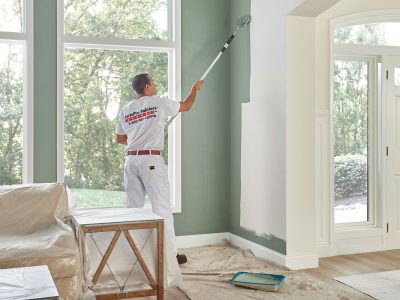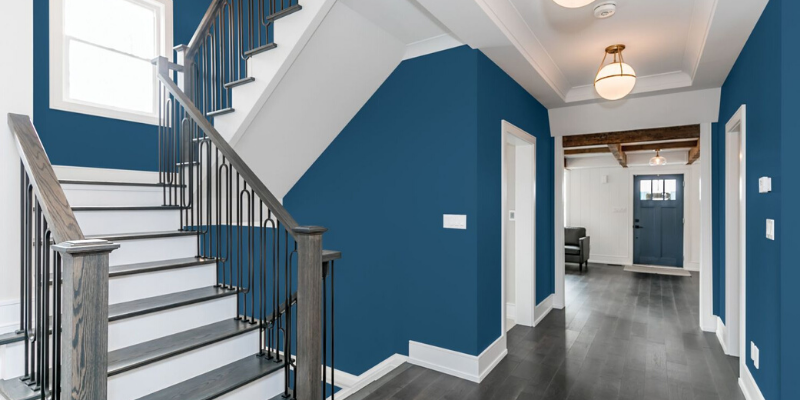Cleveland Metro Painting Specialists: Your Experts for Professional Painting Services
Cleveland Metro Painting Specialists: Your Experts for Professional Painting Services
Blog Article
Enhance Your Inside Layout With Comprehensive Shade Examination
The integration of color assessment into indoor layout offers a distinct possibility to refine and raise the visual and psychological vibration of a room. By involving with a skilled shade specialist, you can navigate the complexities of color option, making sure that your choices not only enhance building attributes but also resonate with individual design and emotional influence.
Advantages of Color Assessment

Additionally, shade appointment help in optimizing all-natural light and maximizing spatial assumption. Lighter hues can make a room appear more expansive, while darker shades develop an intimate setting. Cleveland Metro Painting Specialists. This critical application of shade can considerably affect the general ambiance of any type of interior area
In addition, professional consultants possess an extensive understanding of present patterns and timeless classics, making certain that the chosen colors will remain appealing over time. This insight can conserve clients from pricey redesigns in the future. Ultimately, shade examination encourages customers by offering them with a clear vision and direction, cultivating confidence in their design selections and eventually causing a more successful and satisfying interior decoration result.
Comprehending Shade Psychology
The value of shade psychology in interior decoration can not be overemphasized, as it digs into the emotional and mental results that various hues can evoke in people. Colors can affect mood, habits, and even efficiency, making them a critical consideration in any kind of design job.
For example, warm shades such as red, orange, and yellow are frequently linked with energy and warmth. They can boost sensations of exhilaration and comfort, making them ideal for social spaces like living spaces or kitchens. Alternatively, trendy shades like blue, green, and purple have a tendency to stimulate peace and tranquility, making them optimal for rooms or reflection locations.
Additionally, the use of neutral tones can create a balanced environment by enabling the bolder colors to stick out without frustrating the detects. Recognizing these emotional influences makes it possible for developers to create spaces that not just look visually pleasing however likewise promote emotional health.
Including shade psychology into interior design involves a thoughtful option of hues customized to the desired feature of each area, eventually improving the overall experience for its residents. This awareness is vital for attaining a harmonious and practical indoor setting.
The Shade Wheel Discussed
Comprehending the connections in between tones is crucial for effective interior decoration, and the shade wheel acts as a valuable device in this process. The color wheel, created by Isaac Newton in the 17th century, illustrates the spectrum of shades organized in a circular style. It consists of key colors-- red, blue, and yellow-- that can not be produced by blending various other colors. Second shades, developed by combining main colors, consist of green, orange, and purple. Tertiary shades result from blending a primary and a second color, bring about colors such as turquoise and red-orange.
The shade wheel aids designers understand the connections between shades, including complementary, analogous, and triadic schemes. Corresponding shades, positioned contrary each various other on the wheel, create vibrant contrasts that can stimulate a space. Similar shades, located beside each other, supply a natural and unified appearance. Triadic plans utilize three evenly spaced shades, offering balance and aesthetic rate of interest.
Using the color wheel in you can try here interior design not only improves aesthetic charm however likewise stimulates certain feelings and atmospheres, making it an important referral for shade assessment. Comprehending these partnerships eventually encourages developers to create rooms that are both practical and aesthetically captivating.
Selecting the Right Scheme
A well-chosen shade scheme can link a space, boost its features, and evoke desired emotions. Different rooms serve diverse features and need palettes that show their desired use; for circumstances, tranquil colors such as soft blues or environment-friendlies function well in bedrooms, promoting leisure.
Light can considerably modify just how shades appear, so it is crucial to assess the room at different times of the day. A harmonious combination must complement these functions, producing a cohesive look throughout the area.
When picking shades, utilize the 60-30-10 guideline, which suggests that 60% of the area ought to be a dominant color, 30% an additional shade, and 10% an accent shade. This proportion makes certain equilibrium and aesthetic passion (Cleveland Metro Painting Specialists). Sample colors on the walls prior to devoting, as this permits you to see how the hues connect with one an additional and the general atmosphere they create in your indoor layout job.
Working With a Shade Professional

When functioning with a shade professional, the procedure typically starts with a first appointment. Throughout this meeting, you'll discuss your vision, preferences, and the existing components in your area. The professional will certainly evaluate your needs and may advise details shade combinations that line up with your goals.
After developing an instructions, the expert will provide examples and aesthetic help to help you envision the proposed color pattern. This step is critical, as colors can show up in different ways under varying lights conditions.
Furthermore, a color specialist can guide you in selecting corresponding home furnishings, artwork, and accessories to harmonize with your picked combination. By teaming up carefully, you can attain a refined visual that raises your insides and produces a welcoming environment. Inevitably, the proficiency of a shade consultant can dramatically improve the total impact of your layout project.
Final Thought
In recap, extensive shade examination acts as an important device for enhancing indoor design. By leveraging professional knowledge of shade psychology and spatial dynamics, a customized color scheme can be created to evoke particular feelings and create a harmonious atmosphere. This strategic method not just fosters a cohesive style story but likewise mitigates the danger of pricey redesigns. Ultimately, engaging with a shade consultant makes sure an informed and aesthetically pleasing end result, raising the total experience of the area.
By engaging go right here with a seasoned color specialist, you can navigate the intricacies of shade selection, making sure that your selections not just complement building features yet additionally resonate with individual style and psychological impact. It comprises main colors-- red, blue, and yellow-- that can not be produced by blending other colors.The color wheel helps designers grasp the relationships between colors, including complementary, similar, and triadic schemes.When selecting shades, use the 60-30-10 guideline, which recommends that 60% of the area ought to be a leading color, 30% a secondary shade, and 10% an accent color. By leveraging expert expertise of shade psychology and spatial dynamics, a customized shade combination can be developed to stimulate certain emotions and develop an unified atmosphere.
Report this page